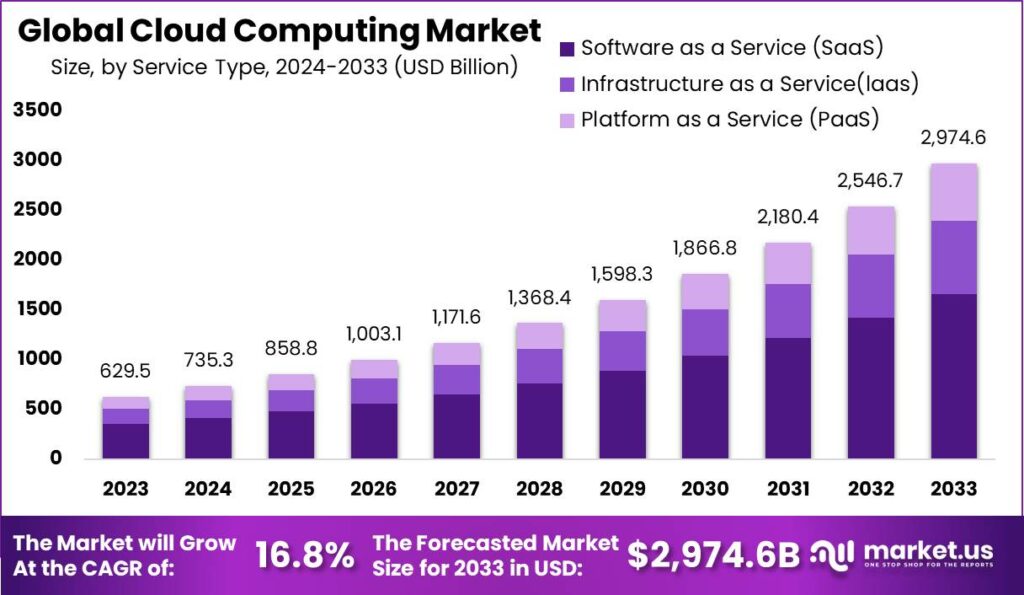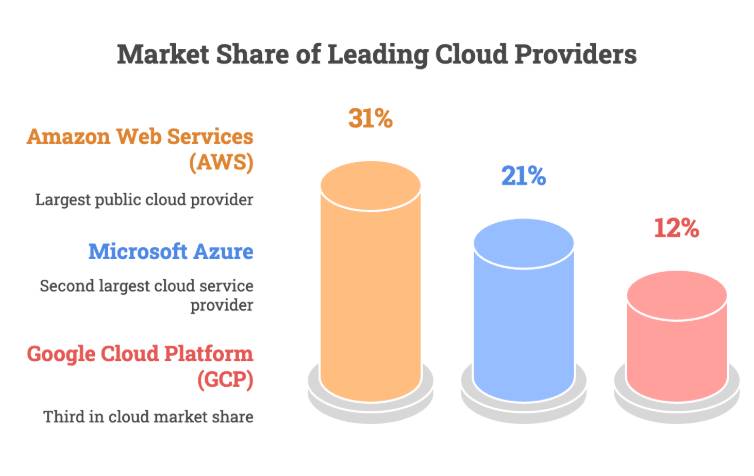WHAT WE HAVE ON THIS PAGE
Introduction
Cloud Computing Statistics: Cloud computing has revolutionized the way businesses and individuals interact with technology. Simply put, it allows you to store, manage, and process data over the internet, instead of relying on local servers or personal devices. Today, almost every industry – from healthcare to finance, retail to manufacturing – leverages the cloud in some way. And as technology advances, the adoption of cloud computing continues to accelerate.
Around 94% of enterprises worldwide are using cloud services in some capacity. This is a clear indication of the widespread adoption across industries, with companies realizing the benefits of scalability, cost savings, and flexibility. The public cloud services market generated $500 billion in revenue in 2023, and it’s projected to surpass $700 billion by 2025. Major players like Amazon Web Services (AWS), Microsoft Azure, and Google Cloud dominate the sector, with AWS alone accounting for 32% of the market share.
Editor’s Choice
- 94% of businesses now use some form of cloud service, and this trend spans industries, not just tech companies. Businesses of all sizes are turning to cloud solutions to remain competitive.
- Today, 60% of all corporate data is stored in the cloud. This shows how crucial cloud storage has become in managing vast amounts of business data.
- Approximately 82% of enterprises have adopted a hybrid cloud strategy, combining both public and private cloud solutions. This approach allows businesses to enjoy a balance of flexibility, cost-efficiency, and heightened security.
- Global spending on cloud services is set to hit $1.3 trillion by 2025, highlighting the massive investment businesses are making in this technology.
- Amazon Web Services (AWS) leads the cloud market, holding a dominant 31% share in 2024, proving its strong influence in the sector.
- Businesses are wasting as much as 32% of their cloud spend, pointing to inefficiencies in how cloud resources are utilized.
- A staggering over one-third of cloud data breaches are caused by misconfiguration or human error, underscoring the need for improved cloud management practices.
- In 2024, 83% of enterprise CIOs planned to repatriate at least some workloads, indicating a shift in how organizations are balancing cloud and on-premise systems.
- Cloud computing can help businesses save 30-40% in IT infrastructure and operational costs, mainly due to its pay-as-you-go pricing model, which reduces the need for large upfront investments and long-term maintenance.
- The demand for cloud data storage is rapidly growing. As of 2023, over 50% of global data is stored in the cloud, and this number is expected to double by 2026. This shows just how essential cloud storage is for managing the explosion of data in today’s digital world.
- Despite concerns over security, 60% of businesses now believe that cloud systems are just as secure – or even more secure – than traditional on-premise systems, due to advanced encryption, backup solutions, and cloud vendor certifications.
Further Reading Suggestions
- Esports Content Creation Market
- Metaverse Statistics
- Podcasting Market
- Semiconductor Market
- AI in Predictive Policing Market
Cloud Computing Growth Statistics
- 42.5% of EU enterprises purchased cloud computing services in 2023, primarily for email, file storage, and office software.
- A staggering 97% of enterprise cloud applications are unsanctioned. This means that employees, teams, or departments often purchase new tools without formal approval to enhance their productivity.
- The world generates 2.5 quintillion bytes of data every day, emphasizing the growing need for efficient data storage solutions like the cloud.
- By 2025, 200 ZB (zettabytes) of data will be stored in the cloud, a huge leap that reflects the increasing demand for cloud storage.
- 60% of the world’s corporate data is already stored in the cloud, a trend that’s only expected to grow as more businesses move to the cloud.
- Cloud data centers contribute 3% of the world’s total energy consumption, raising ongoing concerns about energy use and sustainability in the cloud industry.
- Cloud infrastructure services are a massive revenue driver, generating $178 billion annually.
- 90% of large enterprises have adopted a multi-cloud strategy, reflecting a preference for using multiple cloud providers to avoid vendor lock-in and optimize performance.
- Enterprises typically use an average of 2.6 public and 2.7 private clouds, combining both to meet their specific needs for flexibility and security.
- 41.4% of global tech and business leaders plan to increase their investment in cloud services, showing the growing confidence in the cloud’s role in future business strategies.
- The average spending per employee in the Platform as a Service (PaaS) market is expected to reach around $48.25, highlighting the continued importance of PaaS in enterprise operations.
- According to a survey, 91% of respondents agree that public cloud platforms are critical for disaster recovery strategies, underscoring their importance in business continuity planning.
Cloud Computing Market Size
The Global Cloud Computing Market is projected to experience significant growth, with a forecasted market size of approximately USD 2,974.6 billion by 2033, up from USD 629.5 billion in 2023. This represents a compound annual growth rate (CAGR) of 16.8% over the forecast period from 2024 to 2033. In terms of regional distribution, North America accounted for the largest market share, contributing approximately 39.3% of the global revenue in 2023.

Key Takeaways
- The Software as a Service (SaaS) segment led the market, securing a major revenue share of 55.8% in 2023. SaaS continues to be a dominant force in cloud services due to its scalability and ease of use.
- The private cloud segment held the second-largest share of the market, with a revenue contribution of 43.1% in 2023. This reflects the growing preference for secure, customized cloud environments among businesses that require more control over their data and infrastructure.
- The large enterprises segment captured the largest revenue share, accounting for 59.0% of the market in 2023. Larger organizations are more likely to invest in robust cloud infrastructure to support complex, high-volume operations.
- The BFSI (Banking, Financial Services, and Insurance) sector dominated the cloud market with 21.5% of the revenue share in 2023. The BFSI industry’s need for security, compliance, and scalability has made it a major adopter of cloud technologies.
- North America led the global cloud computing market, holding the largest revenue share of 39.3% in 2023. The region remains a key hub for cloud innovation and adoption, driven by the presence of major cloud providers and advanced tech infrastructure.
Market Leaders

Source: nextwork.org
Regional Analysis
In 2023, North America held a dominant market position in the global cloud computing market, capturing more than a 39.3% share, equivalent to USD 247.3 billion in revenue. North America’s dominance in the global cloud computing market can be attributed to several key factors.
First, the region is home to the world’s largest and most advanced technology companies, including industry giants like Amazon, Microsoft, and Google, which are pioneers in cloud services. These companies have been able to innovate and scale their cloud offerings rapidly, setting the stage for widespread adoption across various sectors. Additionally, North America benefits from a well-developed digital infrastructure, high internet penetration rates, and a robust regulatory environment that supports data security and privacy concerns.
Another significant factor is the region’s strong business ecosystem, where both large enterprises and emerging startups are heavily investing in cloud technologies to drive operational efficiency, enhance customer experience, and enable digital transformation. North America also leads in the adoption of advanced technologies like artificial intelligence, machine learning, and big data analytics, all of which integrate seamlessly with cloud platforms, further boosting the demand for cloud services.
Moreover, government initiatives and favorable policies in North America have fostered a conducive environment for cloud computing growth. The U.S. and Canadian governments, for example, have launched multiple initiatives aimed at expanding digital infrastructure and promoting innovation in technology sectors. The combination of strategic investments, a favorable regulatory climate, and an early adopter mentality has allowed North America to maintain its leadership in the cloud computing space.

Emerging Trends
- Serverless Computing Growth: Serverless computing has been gaining momentum as companies look for ways to streamline infrastructure management. With serverless models, businesses only pay for the resources they use, making it a cost-effective solution.
- Hybrid Cloud Adoption: The hybrid cloud model is becoming a go-to choice for businesses aiming to balance security and scalability. Companies are leveraging both public and private cloud environments to optimize their IT operations.
- AI & Cloud Integration: AI and machine learning services hosted in the cloud are revolutionizing data analytics and automation. With easy access to powerful computing resources, businesses can now implement AI models at scale. The integration of AI in cloud services is predicted to rise by 28% year-over-year.
- Cloud-Native Applications: The shift toward cloud-native application development is accelerating, driven by the need for faster innovation and increased flexibility. Cloud-native tools and platforms like Kubernetes are enhancing developer productivity and reducing downtime, increasing the adoption rate by 30% annually.
Edge Computing Expansion: With the rise of IoT devices and the need for faster data processing, edge computing is gaining ground as a complement to cloud infrastructure. This technology allows for data to be processed closer to the source, cutting down latency and enhancing performance.
Top Use Cases
- Disaster Recovery and Business Continuity: Businesses are increasingly adopting cloud computing for disaster recovery, allowing for a more reliable and cost-effective way to back up and restore data. By using cloud infrastructure, companies are able to reduce recovery time and protect mission-critical data.
- Collaboration and Productivity Tools: The demand for cloud-based collaboration tools, such as Google Workspace and Microsoft 365, has skyrocketed as remote work has become the norm. Cloud services allow teams to work seamlessly from anywhere in the world, enhancing productivity and communication.
- Data Analytics and Big Data Processing: Cloud computing enables organizations to store and analyze massive amounts of data without the need for expensive on-premise infrastructure. The ability to run sophisticated data analytics in the cloud has unlocked new insights for businesses in various industries.
- Internet of Things (IoT) Integration: IoT devices generate massive volumes of data that need to be processed quickly and efficiently. Cloud computing offers the storage and processing capabilities necessary to manage this data, enabling businesses to harness the full potential of IoT for real-time decision-making.
- Cloud Gaming: Cloud gaming platforms like Google Stadia and NVIDIA GeForce Now are changing the gaming landscape, providing users with high-quality gaming experiences without the need for high-end hardware. This market is projected to grow by 22.5% annually.
Attractive Opportunities
- Cloud Security Solutions: With increasing cybersecurity risks, the demand for secure cloud services is at an all-time high. Businesses are looking for robust security features like encryption and threat detection.
- Cloud-Based AI and Analytics: Cloud platforms are an excellent environment for running AI models and conducting big data analytics.
- Cloud-Native Technologies: As more companies embrace DevOps and continuous delivery, cloud-native technologies like containers and Kubernetes are gaining popularity. The global container market alone is forecasted to grow by 22% in the next four years.
- Industry-Specific Cloud Solutions: Many sectors such as healthcare, finance, and manufacturing are seeing customized cloud solutions tailored to their needs. This trend is creating significant investment opportunities.
- 5G and Cloud Synergy: With the rollout of 5G, the potential for cloud applications that require real-time data processing is enormous. The integration of 5G with cloud computing will unlock a range of opportunities, particularly in sectors like autonomous vehicles, smart cities, and IoT.
Sources:
- https://www.cloudzero.com/blog/cloud-computing-statistics/
- https://www.nextwork.org/blog/cloud-computing-stats-2025
- https://www.coolest-gadgets.com/cloud-computing-statistics/
- https://www.mindinventory.com/blog/cloud-computing-statistics/
- https://cloud.google.com/blog/transform/top-cloud-computing-trends-facts-statistics-2023
- https://spacelift.io/blog/cloud-computing-statistics
- https://www.g2.com/articles/cloud-computing-statistics
- https://ec.europa.eu/eurostat/statistics-explained/index.php?title=Cloud_computing_-_statistics_on_the_use_by_enterprises
- https://www.linkedin.com/pulse/cloud-computing-market-pioneering-next-wave-digital-transformation-c7tqc
- https://medium.com/@pramod_50244/cloud-computing-the-future-of-data-management-and-storage-196d0c0e1306
- https://scoop.market.us/cloud-computing-market-to-be-worth-usd-2974-6-billion-by-2033/
ABOUT AUTHOR
Yogesh Shinde is a passionate writer, researcher, and content creator with a keen interest in technology, innovation and industry research. With a background in computer engineering and years of experience in the tech industry. He is committed to delivering accurate and well-researched articles that resonate with readers and provide valuable insights. When not writing, I enjoy reading and can often be found exploring new teaching methods and strategies.







